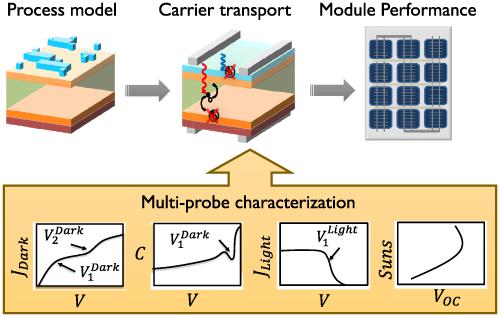当前位置:
X-MOL 学术
›
Prog. Photovoltaics
›
论文详情
Our official English website, www.x-mol.net, welcomes your
feedback! (Note: you will need to create a separate account there.)
Device physics underlying silicon heterojunction and passivating‐contact solar cells: A topical review
Progress in Photovoltaics ( IF 8.0 ) Pub Date : 2018-01-15 , DOI: 10.1002/pip.2959 Raghu V. K. Chavali 1 , Stefaan De Wolf 2 , Muhammad A. Alam 1
Progress in Photovoltaics ( IF 8.0 ) Pub Date : 2018-01-15 , DOI: 10.1002/pip.2959 Raghu V. K. Chavali 1 , Stefaan De Wolf 2 , Muhammad A. Alam 1
Affiliation

|
The device physics of commercially dominant diffused‐junction silicon solar cells is well understood, allowing sophisticated optimization of this class of devices. Recently, so‐called passivating‐contact solar cell technologies have become prominent, with Kaneka setting the world's silicon solar cell efficiency record of 26.63% using silicon heterojunction contacts in an interdigitated configuration. Although passivating‐contact solar cells are remarkably efficient, their underlying device physics is not yet completely understood, not in the least because they are constructed from diverse materials that may introduce electronic barriers in the current flow. To bridge this gap in understanding, we explore the device physics of passivating contact silicon heterojunction (SHJ) solar cells. Here, we identify the key properties of heterojunctions that affect cell efficiency, analyze the dependence of key heterojunction properties on carrier transport under light and dark conditions, provide a self‐consistent multiprobe approach to extract heterojunction parameters using several characterization techniques (including dark J‐V, light J‐V, C‐V, admittance spectroscopy, and Suns‐Voc), propose design guidelines to address bottlenecks in energy production in SHJ cells, and develop a process‐to‐module modeling framework to establish the module's performance limits. We expect that our proposed guidelines resulting from this multiscale and self‐consistent framework will improve the performance of future SHJ cells as well as other passivating contact‐based solar cells.
中文翻译:

硅异质结和钝化接触太阳能电池的基础器件物理:专题综述
商业上占主导地位的扩散结硅太阳能电池的器件物理原理已广为人知,可以对此类器件进行复杂的优化。近来,所谓的钝化接触太阳能电池技术变得非常重要,Kaneka使用指叉配置的硅异质结触点将世界上的硅太阳能电池效率创下了26.63%的纪录。尽管钝化接触式太阳能电池非常有效,但其底层器件的物理原理尚未完全理解,至少因为它是由多种材料构成的,这些材料可能会在电流中引入电子势垒。为了弥合这种理解上的差距,我们探索了钝化接触硅异质结(SHJ)太阳能电池的器件物理原理。这里,oc),提出设计指南以解决SHJ电池中能量产生的瓶颈,并开发过程到模块的建模框架以建立模块的性能极限。我们希望,从这种多尺度且自洽的框架中得出的拟议指南将改善未来的SHJ电池以及其他钝化的基于接触的太阳能电池的性能。
更新日期:2018-01-15
中文翻译:

硅异质结和钝化接触太阳能电池的基础器件物理:专题综述
商业上占主导地位的扩散结硅太阳能电池的器件物理原理已广为人知,可以对此类器件进行复杂的优化。近来,所谓的钝化接触太阳能电池技术变得非常重要,Kaneka使用指叉配置的硅异质结触点将世界上的硅太阳能电池效率创下了26.63%的纪录。尽管钝化接触式太阳能电池非常有效,但其底层器件的物理原理尚未完全理解,至少因为它是由多种材料构成的,这些材料可能会在电流中引入电子势垒。为了弥合这种理解上的差距,我们探索了钝化接触硅异质结(SHJ)太阳能电池的器件物理原理。这里,oc),提出设计指南以解决SHJ电池中能量产生的瓶颈,并开发过程到模块的建模框架以建立模块的性能极限。我们希望,从这种多尺度且自洽的框架中得出的拟议指南将改善未来的SHJ电池以及其他钝化的基于接触的太阳能电池的性能。











































 京公网安备 11010802027423号
京公网安备 11010802027423号